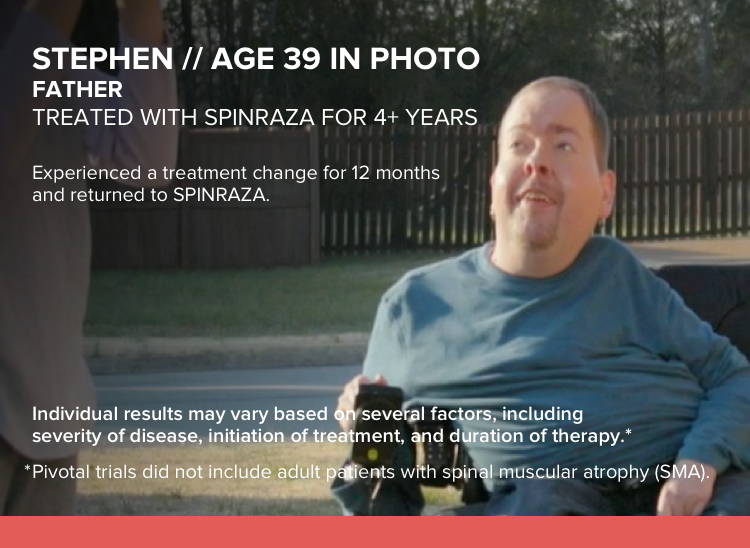WHY SPINRAZA/LATER-ONSET STUDIES
People with later-onset SMA treated with SPINRAZA showed significant improvements in motor function in the CHERISH study
In clinical studies, on average, individuals with later-onset SMA treated with SPINRAZA experienced maintenance of, or even saw improvements in, current muscle function.
People on SPINRAZA had a 3.9-point improvement in overall motor function versus a 1.0-point decline in the untreated control group.
Pivotal study: CHERISH
Who: 126 individuals aged 2 to 9 years with later-onset SMA
Study time: 15 months
Primary outcome: Changes in motor function measured on the HFMSE
Secondary outcome: Changes in upper limb function measured on the RULM and percentage of individuals who had a clinically meaningful improvement of 3 or more points from baseline in HFMSE score
Limitation: The dosing schedule was different than the approved SPINRAZA schedule
Safety: The most common side effects were fever (43%), headache (29%), vomiting (29%), and back pain (25%)
A real-world study for older children and adults on SPINRAZA with an extensive follow-up period of up to 30 months
Łusakowska Study
This study was supported by a grant from Biogen.
This study looked at how well patients were doing in different activities, using different assessments dependent on their functional abilities (HFMSE [n=73 ambulatory and sitters], RULM [n=51, used for nonambulatory and ambulatory patients], CHOP INTEND [n=47, used for non or weak sitters], 6MWT [n=27], and PGI-I [n=120]).
Highlights of the study:
- Included 120 children and adults (5 to 66 years old) with SMA (Types 1c-3)
- One of the longest real-world studies, with individuals assessed for up to 30 months
- Most individuals (74%) had SMA Type 3, and the average age at baseline was 32 years
- Safety reported in the study is generally consistent with the safety reported in the SPINRAZA clinical trials
Limitations of the study: Observational study that does not include a comparison with an untreated group. This type of study is valuable, but not as strong as a pivotal study.
The study was conducted at multiple treatment centers in Poland; practices may vary by country.
Only 12 participants had SMA Type 1c and 19 had SMA Type 2.
The dosing schedule in the study was different from the approved SPINRAZA schedule.
Missing data for some timepoints, some due to COVID, some because patients had not yet reached those timepoints.
The scale used to measure self-reported improvement (PGI-I) relies on what patients say and hasn’t been proven in SMA.
A real-world study for teens and adults on SPINRAZA with a follow-up period of up to 38 months
SMArtCARE Study
This study assessed 3 functional outcome measures: HFMSE (clinically meaningful improvement defined as a change of ≥3 points), RULM (clinically meaningful improvement defined as a change of ≥2 points), and 6MWT (for ambulatory individuals, clinically meaningful improvement defined as an increase in walking distance by ≥30 meters).
Highlights of the study:
- Included 237 teens and adults between the ages of 16 and 71 years old, with an average age of 36 years*
- One of the longest real-world evidence studies, with individuals assessed for up to 38 months
- Included individuals with SMA Types 1, 2, 3, and 4
*Functional outcomes were assessed at baseline, 14, 26, and 38 months of treatment.
Limitations of the study: Observational study does not include a comparison with an untreated group. This type of study is valuable, but not as strong as a pivotal study.
Limited to patients from 3 countries–Austria, Germany, Switzerland; practices may vary by country.
Limitations of HFMSE and RULM in capturing the full range of possible responses.
The dosing schedule in the study was different from the approved SPINRAZA schedule.
*Functional outcomes were assessed at baseline, 14, 26, and 38 months of treatment.
Supportive studies: CS2/CS12
Who: 28 individuals aged 2 to 15 years with later-onset SMA treated with SPINRAZA
Study time: approximately 3 years
Primary outcome: These supportive studies were designed to determine the safety of SPINRAZA
Other outcomes: The safety and longer-term effects of SPINRAZA on overall motor function, upper limb function and walking ability were also studied
Limitations: The dosing was different than the approved SPINRAZA schedule. Additionally, these studies had no untreated control group and a small number of participants and so may not be as reliable as the clinical trial data.
This type of study is valuable, but not as strong as a pivotal study.
Safety: Side effects were consistent with those reported in the pivotal trials


“Having SMA, I set the example by doing things that could be perceived as difficult. Yeah, I still have SMA, but I don't let SMA stop me.”



